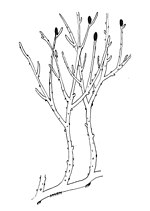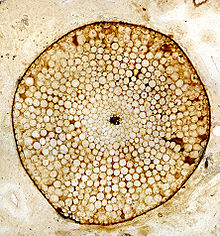
The Rhynie chert is a Lower Devonian sedimentary deposit exhibiting extraordinary fossil detail or completeness. It is exposed near the village of Rhynie, Aberdeenshire, Scotland; a second unit, the Windyfield chert, is located some 700 m away.
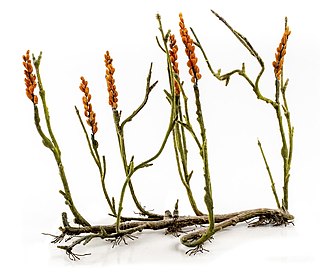
The zosterophylls are a group of extinct land plants that first appeared in the Silurian period. The taxon was first established by Banks in 1968 as the subdivision Zosterophyllophytina; they have since also been treated as the division Zosterophyllophyta or Zosterophyta and the class or plesion Zosterophyllopsida or Zosteropsida. They were among the first vascular plants in the fossil record, and had a world-wide distribution. They were probably stem-group lycophytes, forming a sister group to the ancestors of the living lycophytes. By the late Silurian a diverse assemblage of species existed, examples of which have been found fossilised in what is now Bathurst Island in Arctic Canada.

Asteroxylon is an extinct genus of vascular plants of the Division Lycopodiophyta known from anatomically preserved specimens described from the famous Early Devonian Rhynie chert and Windyfield chert in Aberdeenshire, Scotland. Asteroxylon is considered a basal member of the Lycopsida.
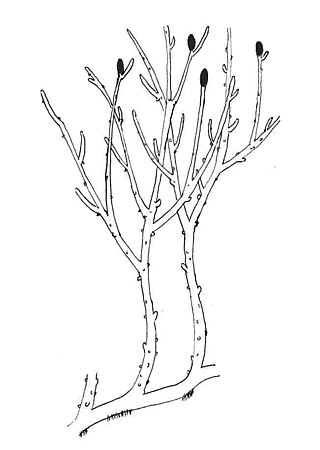
The rhyniophytes are a group of extinct early vascular plants that are considered to be similar to the genus Rhynia, found in the Early Devonian. Sources vary in the name and rank used for this group, some treating it as the class Rhyniopsida, others as the subdivision Rhyniophytina or the division Rhyniophyta. The first definition of the group, under the name Rhyniophytina, was by Banks, since when there have been many redefinitions, including by Banks himself. "As a result, the Rhyniophytina have slowly dissolved into a heterogeneous collection of plants ... the group contains only one species on which all authors agree: the type species Rhynia gwynne-vaughanii". When defined very broadly, the group consists of plants with dichotomously branched, naked aerial axes ("stems") with terminal spore-bearing structures (sporangia). The rhyniophytes are considered to be stem group tracheophytes.
Robert Kidston was a Scottish botanist and palaeobotanist.

Trimerophytopsida is a class of early vascular plants from the Devonian, informally called trimerophytes. It contains genera such as Psilophyton. This group is probably paraphyletic, and is believed to be the ancestral group from which both the ferns and seed plants evolved. Different authors have treated the group at different taxonomic ranks using the names Trimerophyta, Trimerophytophyta, Trimerophytina, Trimerophytophytina and Trimerophytales.
Ornatifilum is an artificial form genus, which is used to categorise any small, branched filaments with external ornamentation.

Polysporangiophytes, also called polysporangiates or formally Polysporangiophyta, are plants in which the spore-bearing generation (sporophyte) has branching stems (axes) that bear sporangia. The name literally means 'many sporangia plant'. The clade includes all land plants (embryophytes) except for the bryophytes whose sporophytes are normally unbranched, even if a few exceptional cases occur. While the definition is independent of the presence of vascular tissue, all living polysporangiophytes also have vascular tissue, i.e., are vascular plants or tracheophytes. Extinct polysporangiophytes are known that have no vascular tissue and so are not tracheophytes.

Aglaophyton major was the sporophyte generation of a diplohaplontic, pre-vascular, axial, free-sporing land plant of the Lower Devonian. It had anatomical features intermediate between those of the bryophytes and vascular plants or tracheophytes.
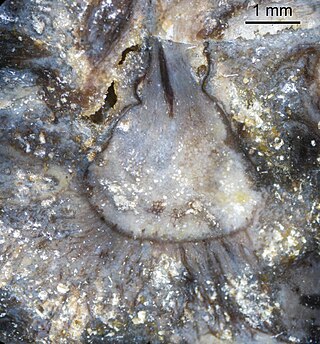
Horneophyton is an extinct early plant which may form a "missing link" between the hornworts and the Rhyniopsida. It is a member of the class Horneophytopsida. Horneophyton is among the most abundant fossil organisms found in the Rhynie chert, a Devonian Lagerstätte in Aberdeenshire, UK. A single species, Horneophyton lignieri, is known. Its probable female gametophyte is the form taxon Langiophyton mackiei.

The Horneophytopsida, informally called horneophytes, are a class of extinct plants which consisted of branched stems without leaves, true roots or vascular tissue, found from the Late Silurian to the Early Devonian. They are the simplest known polysporangiophytes, i.e. plants with sporophytes bearing many spore-forming organs (sporangia) on branched stems. They were formerly classified among the rhyniophytes, but it was later found that some of the original members of the group had simple vascular tissue and others did not. The group has also been treated as the division Horneophyta.
Professor Dianne Edwards CBE, FRS, FRSE, FLS, FLSW is a palaeobotanist, who studies the colonisation of land by plants, and early land plant interactions.

Sciadophyton is a morphotaxon of lower Devonian plants known only from compression fossils. It is interpreted as the monoicous gametophyte of a vascular land plant, because its vascularised branches end in a cup-shaped structure bearing gametangia, both antheridia and archegonia, but little structural information is preserved at the cellular level. It formed rosettes of stems, which may have radiated from a basal gametophytic corm-like thallus or from a central 'stem' or even from a root system, although there is not enough evidence to discriminate between these possibilities.
Hostinella is a form genus, used for bare dichotomously branching stems (axes) which have not been found in association with spore-forming organs or sporangia and so cannot be assigned to a more precise genus or species. Specimens assigned to this genus have been found in Bathurst Island, Canada, in the Bertie Formation of Upper Silurian age, where the stems are approximately 1.2 mm in diameter; and in Lower Devonian Senni beds where the axes have a straited external appearance and contain xylem with tracheids.
Psilophytopsida is a now obsolete class containing one order, Psilophytales, which was previously used to classify a number of extinct plants which are now placed elsewhere. The class was established in 1917, under the name Psilophyta, with only three genera for a group of fossil plants from the Upper Silurian and Devonian periods which lack true roots and leaves, but have a vascular system within a branching cylindrical stem. The living Psilotaceae, the whisk-ferns, were sometimes added to the class, which was then usually called Psilopsida. This classification is no longer in use.
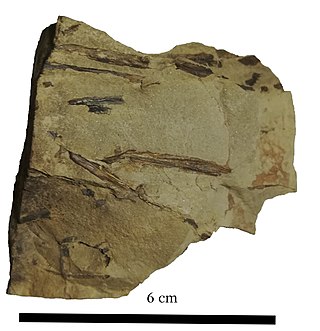
Stockmansella is a genus of extinct plants of the Middle Devonian, fossils of which have been found in north-west Germany. The sporophyte generation consists of prostrate dichotomizing stems (axes) up to 10 cm long and around 3mm wide, which at intervals produce narrower smooth upright stems. These bear sporangia on short lateral branches (sporangiophores). The prostrate stems have bulges from which rhizoids form. Both prostrate and upright stems have a central strand of conducting tissue which contains simple tracheids, so that Stockmansella is a vascular plant.
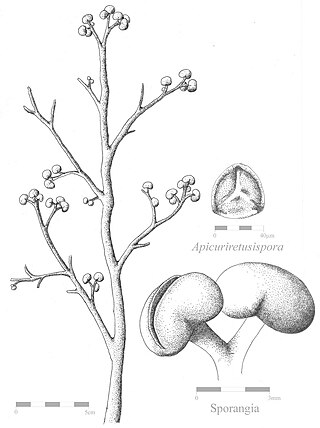
Renalia is a genus of extinct vascular plants from the Early Devonian. It was first described in 1976 from compressed fossils in the Battery Point Formation. It is difficult to reconstruct the original form of the complete plant, but it appears to have consisted of leafless branching stems whose side branches had sporangia at their tips. It is regarded as an early relative of the lycophytes.
Sartilmania is a genus of extinct vascular plants of the Early Devonian. Fossils were found on the Sart Tilman campus of the University of Liège, Belgium.

Adoketophyton is a genus of extinct vascular plants of the Early Devonian. The plant was first described in 1977 based on fossil specimens from the Posongchong Formation, Wenshan district, Yunnan, China. These were originally named Zosterophyllum subverticillatum; later the species was transferred to a new genus as Adoketophyton subverticillatum. One cladistic analysis suggested that it is a lycophyte, related to the zosterophylls. Other researchers regard its placement within the vascular plants as uncertain.
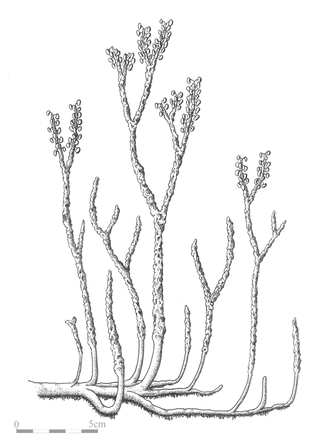
Nothia was a genus of Early Devonian vascular plants whose fossils were found in the Rhynie chert in Scotland. It had branching horizontal underground stems (rhizomes) and leafless aerial stems (axes) bearing lateral and terminal spore-forming organs (sporangia). Its aerial stems were covered with small 'bumps' (emergences), each bearing a stoma. It is one of the best described early land plants. Its classification remains uncertain, although it has been treated as a zosterophyll. There is one species, Nothia aphylla.
